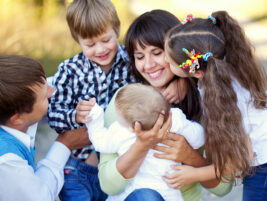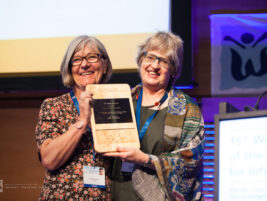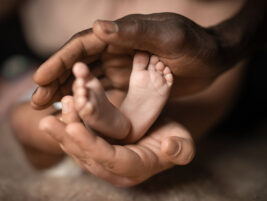When the American Psychological Association asked me to write a short book, to be included in a trauma series, about the impact of trauma on infants and young children and evidence-based interventions and treatments to promote healthy development, I said, “Yes!” right away. I welcomed the opportunity to raise awareness for a broader audience, including undergraduates and graduate students, about the fact that young children in the first three years of life experience a higher percentage of trauma exposure than any other age group. It is also important to recognize that trauma exposure in the earliest years can not only lead to individual and family problems, but also can result in vast societal costs needed to help and support development. This book also provided the opportunity to help readers recognize that the first few years of life is a particularly sensitive time for brain development as well as cognitive, social and emotional growth and that adversity because of, or as a result of, trauma experienced in the first few years of life may be particularly detrimental developmentally. Findings from the landmark Adverse Childhood Experiences Study (ACES) have indicated that children experiencing trauma and other adverse experiences in the earliest years (e.g., domestic violence, abuse, neglect) are at increased risk for difficulties during middle childhood and adolescence and physical and mental health problems in adulthood (e.g., depression, anxiety, heart disease). In addition, the ACES study demonstrated the societal cost of exposure to trauma in early life. This study has shown that individuals with greater numbers of adverse childhood experiences were also more likely to experience social problems, such as unemployment, family violence and parenting problems, as well as a higher use of health and social services.
It is important for those receiving training in both child development and mental health or behavioral health disciplines to understand that trauma, either recognized or unrecognized, contributes to mental health symptoms in young children – and also that some groups are more vulnerable. For example, research has shown that 49% of children living in poverty have been exposed to trauma, and that they are 2 to 5 times more likely to be exposed to violence. A dose-response effect of childhood exposure to trauma has been found such that cumulative trauma places children at higher risk for long-term problems.
My experience over the years in developing and implementing the Louisiana State University Health Sciences Center Harris Center for Infant Mental Health and collaborating with others through the Harris Professional Development Network and in working with WAIMH and Zero to Three has helped me and others learn ways to dispel the myth that young children are not impacted by trauma. Further, there is good evidence that early intervention and treatment can make a difference. A main goal in writing this book has been to: 1) develop a resource to educate psychologists, psychiatrists, social workers, counselors, pediatricians, child development specialists and other health professionals about the impact of trauma on young children and 2) to describe several widely used evidence-based treatments, Child-Parent Psychotherapy, Parent-Child Interaction Therapy, and Attachment Biobehavioral Catch-Up Intervention that are effective in helping these children. In order to better inform the reader about these treatments, we provide a “roadmap” in the book related to the criteria that can be used in making decisions about which treatment might be most helpful for an individual child and caregiver, including how they are used, for what age children they are most effective and why a clinician might choose one treatment rather than another. The importance of behavioral observations and play is also discussed to help the reader understand the ways that young children communicate their feelings before they are able to use language.
The three treatments described in this book include a developmental understanding of expectable behavior in young children and integrate a socio-cultural perspective related to background and beliefs in working with children and families. Emphasis is placed throughout on the importance of the parent–child relationship in supporting infants and young children who are exposed to traumatic events because their sense of security comes from positive experiences with trusting, nurturing relationships. The reader will learn how sensitive relationship-based therapy can be helpful in modifying earlier negative experiences and perceptions.
In conclusion, it is important to raise awareness and provide increased information about infant mental health theory, research and treatment in training programs for all developmental and mental health professionals. Although infant and early childhood mental health has recently become integrated into some training programs and clinical care settings, there are still a limited number that include a comprehensive understanding of infant mental health theory, research and treatment in their curriculum. And yet, there is now abundant evidence not only about the need, but also information about evidence-based treatments that are effective for very young children,
Early identification, evaluation and treatment benefit from specialized training, as often the traumatic responses of infants and young children are misinterpreted or misdiagnosed as developmental delays, difficult temperament, or behavior problems. Because of the burgeoning knowledge about brain development and the immediate and long-term impact of trauma in early life, it is an important time for mental health professionals and those focusing on child development to be informed and trained in evidence-based treatments for young children impacted by trauma. Readers of this book will learn that early traumatic exposure can set a child on a path of developmental, behavioral, emotional and mental health challenges. These challenges can be addressed or moderated by appropriate interventions, support and treatment. My hope is that readers of this book will learn that the negative effects of exposure to trauma can be prevented and that developmental outcomes for children improved significantly with early implementation of evidence-based treatments.
The book is available through the American Psychological Association:
https://www.apa.org/pubs/books/4317448.aspx
and at Amazon:
Authors
Osofsky, Joy D.








